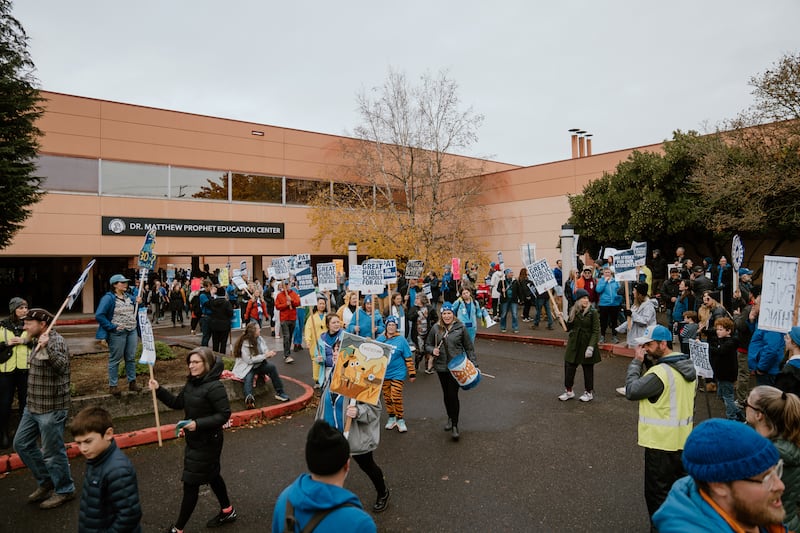Before Portland’s first teachers’ strike set West Coast records, before protesters showed up at the homes of school district leaders, before Caesar the No Drama Llama got involved (we’ll come back to that one), Angela Bonilla arrived on the first picket line.
It was Nov. 1, and a foggy dawn had just broken at Scott Elementary School.
About 50 teachers and parents were walking the picket line on Northeast Prescott Street, chanting “Union! Strong!” when Bonilla appeared. She wore a black moto jacket over a blue Portland Association of Teachers hoodie and glasses with bold mosaic-print frames.
“People, can we give it up for your president, Angela Bonilla,” said a union leader, the crowd parting as Bonilla, 35, walked through to the sound of cheers and cowbell clangs.
A year and a half ago, Bonilla was an instructional coach at this very school.
On this Wednesday morning, Bonilla led her former colleagues through their first-ever picket line as the president of the PAT.
The strike has brought Portland Public Schools, an institution that instructs about 45,000 children and employs 3,500 teachers and a workforce of 4,700 administrators, custodians, secretaries and others, to an anxious halt that has canceled 11 instructional days and brought many working families to their knees. At press deadline Nov. 21, the strike remained unresolved. The earliest Portland students could return to classrooms is Nov. 27.
“If I had to pick someone out of central casting as a union leader for this moment, she would be right up there,” says state Rep. Rob Nosse (D-Portland), himself a former union organizer. “She checks a lot of boxes. She’s very smart. She’s funny. She’s been a teacher, so she can speak from the heart about the job.”
Bonilla’s allies say she’s the only person resolute enough to force the school district to dedicate every available dollar to classrooms rather than its bloated administration.
But in recent days, the strike has turned bitter, and her critics—who now include an increasing number of burned-out parents—say she has exploited the frustrations of teachers and families to pursue an agenda that isn’t supported by actual budget numbers. In a sign of the acrimony, Bonilla originally agreed to an interview with WW but backed out two weeks later via a curt message from her spokeswoman.
Not so long ago, Bonilla explained her motivation. It was simple: She wanted to make Portlanders pay attention to what teachers had to say.
“There’s an urgency—that the district tries to downplay—about the conditions of our schools that I’ve encouraged educators to no longer stay silent about,” Bonilla told WW in a September interview at a union picnic at Laurelhurst Park. “We’re at a breaking point.”
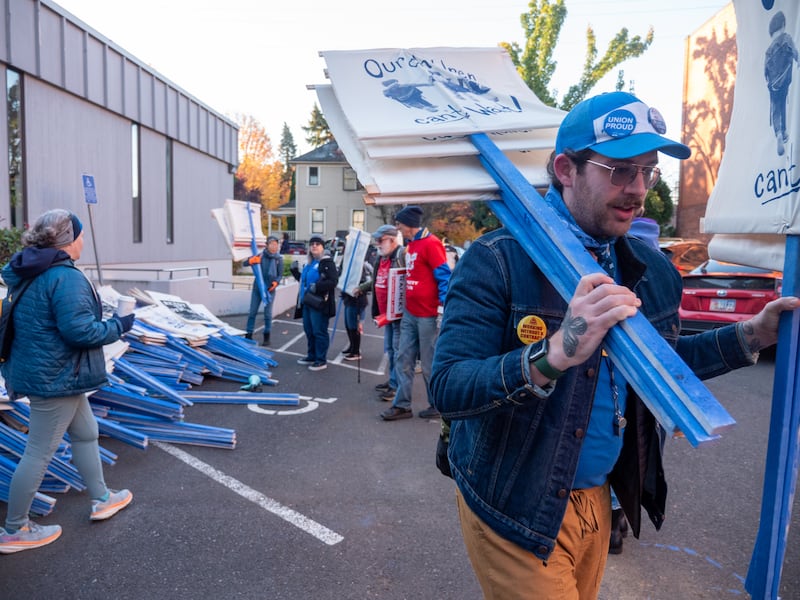
Advocacy has always been in Bonilla’s blood, according to teachers she trained with at Portland State University.
She was raised in the Bronx, the daughter of Dominican immigrants, and grew up speaking both English and Spanish.
After attending public school through the sixth grade, Bonilla received a scholarship to the progressive, $61,100-a-year Calhoun School on Manhattan’s Upper West Side, which features open floor plans to “break down barriers” and “nurture flexibility, provoke inquiry and forge instructive connections.”
She attended Beloit College in Wisconsin and ran a theatrical troupe that used dramatic techniques to bring attention to campus debates on race, class, gender and sexuality. The technique, called the “Theater of the Oppressed,” was developed in the early 1970s by Brazilian director Augusto Boal.
In 2009, she moved to Portland and worked as an assistant teacher for toddlers at a YMCA in Beaverton, changing diapers, serving snacks and singing songs. Bonilla taught at PPS for seven and a half years, earning her master’s in education at PSU along the way. She worked in a variety of roles, including educational assistant, Spanish immersion and instructional coach at Scott Elementary (a job that paid $67,790 a year), before winning her role atop the union, at an annual salary of $113,243.
Venus Kaller worked with Bonilla at Rigler Elementary School and says she always stressed “giving voice to students. Teaching them what their rights are and how they should be treated and respected.”
Isabel Johnson, a Glencoe Elementary School parent who has worked with Bonilla, talked about her ability to start meetings with kind words, bring up uncomfortable subjects like race and gender, and then still end tense meetings with hugs.
“She is one of those people that are just a little shiny—that burn a little brighter than other people,” Johnson says. “She has star power.”
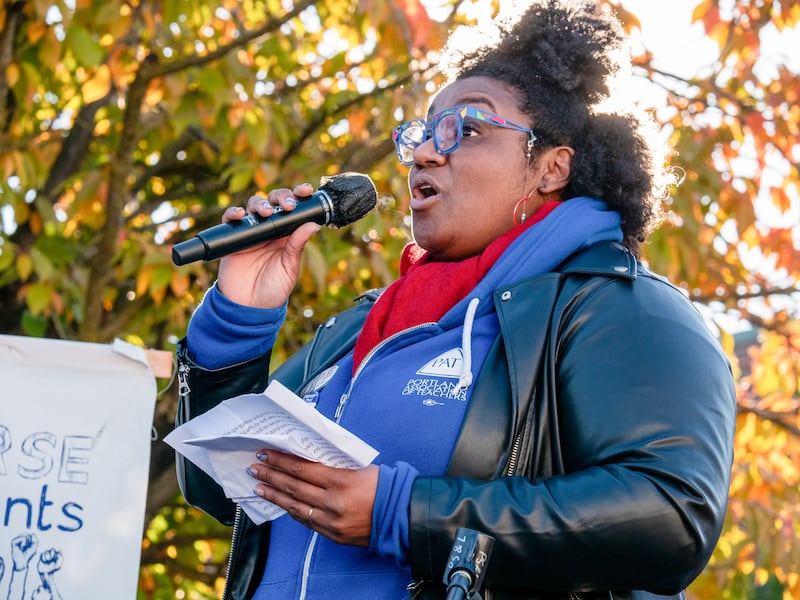
When teachers elected Bonilla to succeed Elizabeth Thiel as PAT president in 2022, she assumed control of the largest teachers’ union in the state.
Nosse, the state lawmaker, says Bonilla’s election was akin to winning public office.
“When you are a union president, you are also a politician,” says Nosse, who has worked for the Oregon Nurses Association. “She doesn’t have to just work with management, she’s got to manage her own side who—rightfully so—has expectations of her. She’s an elected leader.”
Bonilla inherited a membership that felt deeply aggrieved about wages—starting teachers here make $3,300 a year less than their counterparts in North Clackamas and $2,600 less than those in Beaverton—and the working conditions in classrooms, which were sometimes hot, crowded and infested by rodents.
The complaints about work environment and class sizes gave teachers common cause with parents. One of the most visceral picket-line chants has been: “Hot, cold, rats, mold! This is getting really old!”
It’s catnip for parent support.
“Parents want kids somewhere they know they’re safe and they’re cared for and not going to get hurt,” Bonilla said to WW in September. “I had tiles falling from the ceiling in my classroom in multiple buildings. We’re asking for temperatures between 60 and 90 degrees. We’re asking for no mold, no rodents. It’s not wild.”
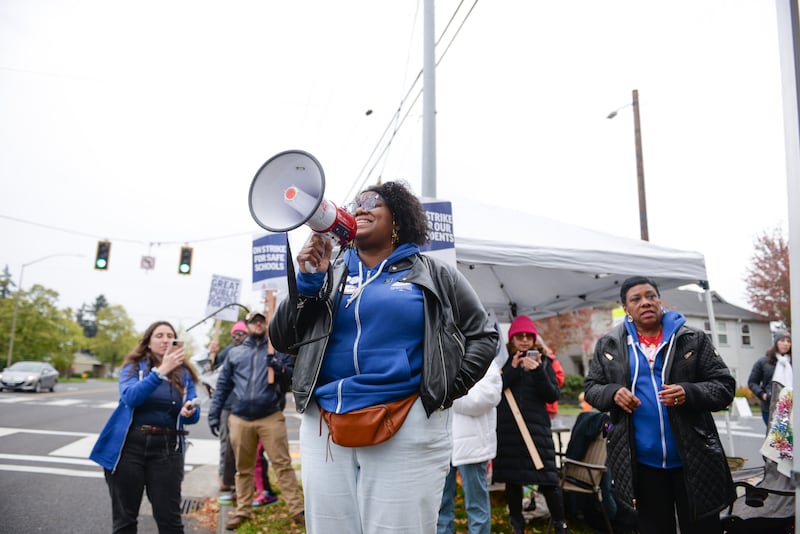
Yet the strike was still a bit of a gamble for the union, because feelings are still raw from the pandemic and its extended Google Meet classrooms, and because Portland already has one of the shortest school years in the country and stubbornly low test scores.
And, in fact, many on the left thought Bonilla went too far when the district beseeched state leaders for money to meet PAT demands and was rebuffed. Gov. Tina Kotek and state Sen. Lew Frederick (D-Portland), both friends of teachers, said the state could offer no additional money to resolve the walkout. (At the onset of the strike, the PPS and PAT contract proposals were $228 million apart.)
A leader at one of Oregon’s other top unions, speaking on condition of anonymity, says nobody should be surprised to see PAT taking an aggressive stance.
“PAT is to the left of OEA,” the leader said, speaking about the Oregon Education Association, which is the statewide teachers’ union that oversees locals within Oregon’s 197 school districts.
Bonilla is running the OEA’s biggest local, in a city that loves teachers and unions.
“PAT is making its decisions factoring in the politics in the city of Portland and the most labor-friendly presidential administration we’ve seen in 50 years,” says Marc Abrams, who is both a former two-term elected member of the Portland School Board and president of the American Federation of State, County and Municipal Employees local that represents lawyers at the Oregon Department of Justice (his son is a PAT member).
Former state Sen. Mark Hass (D-Beaverton) worked extensively on education policy and funding in his 14 years in the Senate and is married to a public schoolteacher. He says the rhetoric he’s hearing from the PAT is new.
“I think the lobbyists and leadership are different from rank-and-file teachers,” Hass says. “They have become much more militant—and I think PAT is more militant than the average Oregon labor group.”
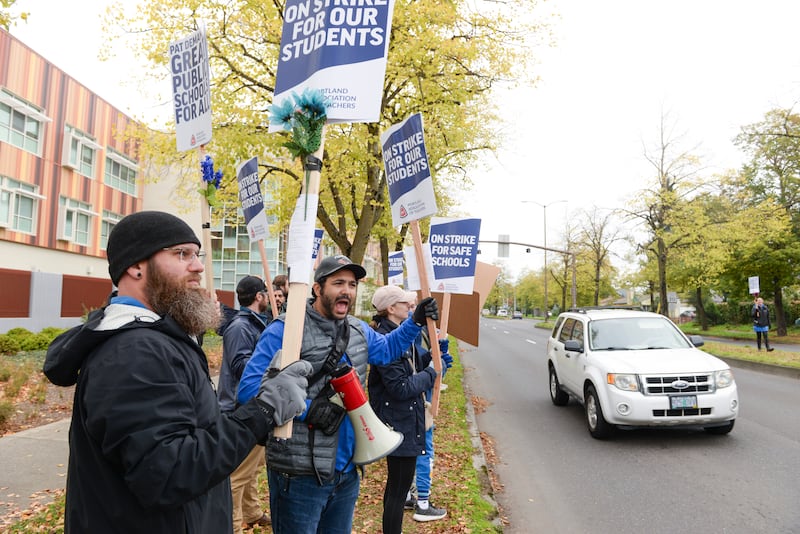
Parent Isabel Johnson praises Bonilla’s star power but wonders about some of the union’s street theater.
On Nov. 8, 1,000 people and the aforementioned llama marched from PAT headquarters to the Oregon Convention Center in search of School Board member Andrew Scott, who was there for a work meeting at his day job for the regional government Metro. Scott had to be escorted out.
A veteran security employee said it was “like nothing he had ever experienced in his years at the OCC” and Metro employees were “upset and traumatized,” according to a letter from the school district’s attorneys. PAT’s leadership downplayed the action as “a little rebellion” on Instagram.
That same day, a demonstration in front of district chief of staff Jonathan Garcia’s home left his wife and neighbors “shaken,” Garcia said. The next morning, Superintendent Guadalupe Guerrero woke up to “Wanted” posters with his face on them all over his neighborhood. The campaign escalated further Nov. 21 when a flyer encouraged people to camp out on board members’ front lawns—and listed their home addresses.
“The way the School Board members have been treated is unacceptable,” Johnson says. “They’re not the evil empire—they are volunteers, they don’t even get paid! I can disagree with Andrew Scott, but I have no doubt about his commitment to education. People are trying to do their best, and if we keep treating them like this, who is going to want to run?
“Plus, I don’t see how it helps us get to a contract.”
That said, Johnson and others believe Bonilla’s hands are clean—some blame union-adjacent fringe groups, others point to more radical factions within PAT.
Bonilla said on social media that she, too, has been a target of personal attacks, including racist and sexist hate mail.
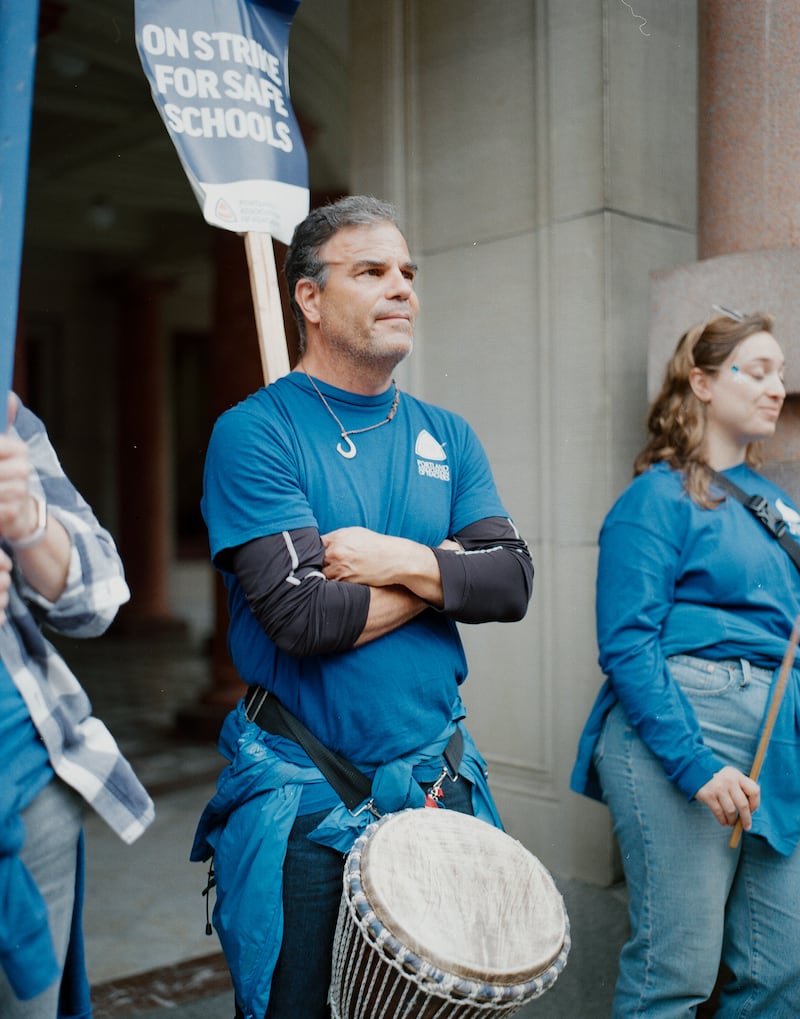
Public-sector bargaining has at least one advantage over the private sector: the inherent financial transparency. There’s also a finite pot of money: A public school system can’t pass the expense of a big contract on to its customers by jacking up prices.
Yet agreement on the underlying numbers has been conspicuously absent from this strike. As early as Oct. 10, teachers were passing around a PAT document titled “A Manufactured Crisis,” demanding that the district use an approximately $100 million rainy-day fund to help fulfill the teachers’ proposal while the school district insisted it could not.
About a week into the strike, labor-friendly Gov. Kotek sent in the state’s chief financial officer to sort out the budget. (“I am taking unprecedented steps to help PPS and PAT establish facts that should have been agreed upon months ago,” Kotek scolded in her statement.)
The analyst uncovered only $12.4 million in new, available funds for the next school year that the district had not noted in its budget documents—a pittance compared to the approximately $200 million gulf between the two contract proposals at that point.
Andy Jacob is the father of two fifth graders and lives in Southeast Portland. He works in education policy and once worked for the New York City Department of Education.
He loves teachers. The union is bringing up “very real, serious issues,” he says, and he’s also “not one to mince words about issues I have with PPS.” But the money has never been there and the stalemate is unacceptable, he says.
“We’d all love it if the answer to this was, ‘Good news! PPS has a magic money faucet and if they just decide to turn it on, we can have everything we want!’” he says. “But it is clear that that is not true and we have to get to a resolution somehow. We have to get our kids back in school.”
Long, unplanned interruptions in classroom instruction take a serious toll on children and families, as society learned from the pandemic. Jacob worries about the children who struggled most during the pandemic closures and are still catching up.
It’s hard to say what’s happening at the bargaining table. The two sides send out daily, conflicting messages to their mailing lists with their own spin. By Nov. 20, they could not even agree whether they’d reached an agreement. Bonilla said they had, but the School Board had kiboshed the deal; Board Chair Gary Hollands said there was no agreement to reject.
Finding peace when the two sides can’t agree on facts may prove thorny.
Bonilla grappled with this issue back in September when PPS first notified parents of a possible strike. “It’s interesting the characterization of our different positions,” she said of the school district’s emails. “I like to tell my students that everyone has a story and the truth is somewhere in the middle.”
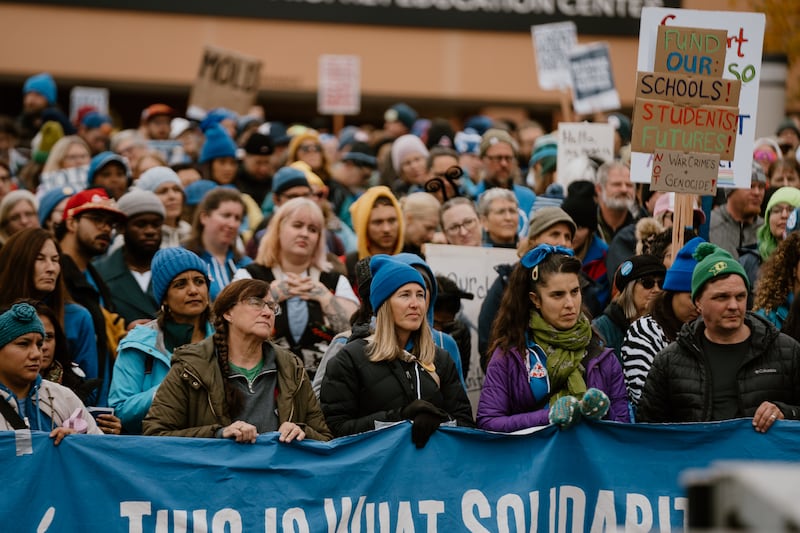
Nevertheless, the parties are no longer so far apart. The two sides are close to agreement on a 13.8% cumulative cost-of-living increase over the next three years that would put more than 50% of the district’s educators over the $100,000 annual salary mark by the end of the third year of the contract. The union has also so far negotiated a major boost in planning time, from 320 minutes a week up to 410 minutes, plus school building improvements and increased mental health supports for students.
In the days before the strike began, Bonilla told WW that the school district was just thinking too small.
“We are literally trying to bring public schools to the level they need to be to serve our community,” Bonilla said. “It’s a bummer to be painted as these crazy teachers who just want the world. Well, then I guess we have a crisis of imagination because I believe we can do these things. I know we can.”
Nigel Jaquiss contributed reporting to this story.
